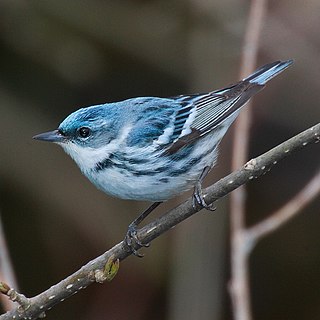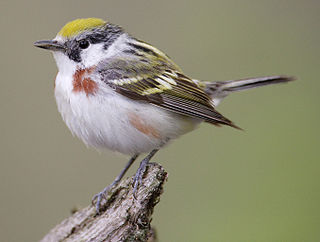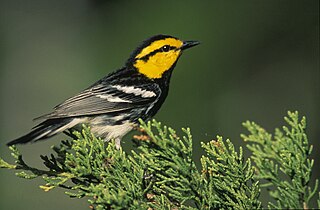 W
WSetophaga is a genus of birds of the New World warbler family Parulidae. It contains at least 33 species. The males in breeding plumage are often highly colorful. The Setophaga warblers are an example of adaptive radiation with the various species using different feeding techniques and often feeding in different parts of the same tree.
 W
WAdelaide's warbler is a bird endemic to the archipelago of Puerto Rico belonging to the genus Setophaga of the family Parulidae. The species is named after Adelaide Swift, daughter of Robert Swift, the person who captured the first specimen.
 W
WThe American redstart is a New World warbler. It is unrelated to the Old World (common) redstart.
 W
WThe yellow warbler is a New World warbler species. Yellow warblers are the most widespread species in the diverse genus Setophaga, breeding in almost the whole of North America, the Caribbean, and down to northern South America.
 W
WThe arrowhead warbler is a species of bird in the family Parulidae. It is endemic to Jamaica. Its natural habitat is subtropical or tropical moist montane forests.
 W
WAudubon's warbler is a small bird of the Parulidae family.
 W
WThe Bahama warbler is a species of bird in the family Parulidae. It is endemic to The Bahamas.
 W
WThe Barbuda warbler is a species of bird in the family Parulidae. It is endemic to the island of Barbuda in Antigua and Barbuda. Its natural habitat is tropical dry shrubland near wetland areas. It is threatened by habitat loss. It once was considered a subspecies of the Adelaide's warbler. In September 2017, the warbler's habitat was massively damaged by Hurricane Irma. Despite this, the species was found to have survived the storm and its aftermath, and later surveys have indicated that the species was not significantly affected by the hurricane. However, it is still threatened by unplanned housing development, garbage dumping, and poor land-use practices.
 W
WThe bay-breasted warbler is a small species of songbird in the New World warbler family, Parulidae. It is one of thirty-four species in the diverse genus Setophaga. Like all songbirds, or passerines, the species is classified in the order Passeriformes.
 W
WThe black-throated blue warbler is a small passerine bird of the New World warbler family. Its breeding ranges are located in the interior of deciduous and mixed coniferous forests in eastern North America. Over the cooler months, it migrates to islands in the Caribbean and Central America. It is very rarely found in western Europe, where it is considered to be a non-indigenous species. The black-throated blue warbler is sexually dimorphic; the adult male has a black face and cheeks, deep blue upperparts and white underparts, while the adult female is olive-brown above and light yellow below.
 W
WThe black-throated gray warbler or black-throated grey warbler is a passerine bird of the New World warbler family Parulidae. It is 13 cm (5.1 in) long and has gray and white plumage with black markings. The male has the bold black throat of its name, and black stripes on its head, as well as black streaks on its flanks; the female is a paler version of the male, with a white throat and less distinct black markings on the flanks and wings. It breeds in western North America from British Columbia to New Mexico, and winters in Mexico and the southwestern United States. The habitats it prefers are coniferous and mixed forests and scrubland, especially those with pinyon pines, junipers, sagebrush, and oaks. Its nest is an open cup of plant fibers lined with feathers, built a few metres from the ground in the branches of a tree or shrub. Three to five eggs are laid, and young are fed by both parents. Common in its breeding range, it does not seem to be seriously threatened by human activities, unlike many migratory warblers.
 W
WThe black-throated green warbler is a small songbird of the New World warbler family.
 W
WThe Blackburnian warbler is a small New World warbler. They breed in eastern North America, from southern Canada, westwards to the southern Canadian Prairies, the Great Lakes region and New England, to North Carolina.
 W
WThe blackpoll warbler is a New World warbler. Breeding males are mostly black and white. They have a prominent black cap, white cheeks and white wing bars. The blackpoll breeds in forests of northern North America, from Alaska throughout most of Canada, to the mountains of New York and New England. They are a common migrant through much of North America. In fall, they fly south to the Greater Antilles and the northeastern coasts of South America in a non-stop long-distance migration over open water, averaging 2500 km, one of the longest distance non-stop overwater flights ever recorded for a migratory songbird. Rare vagrants to western Europe, they are one of the more frequent transatlantic passerine wanderers.
 W
WThe Cape May warbler is a species of New World warbler. It breeds in northern North America. Its breeding range spans all but the westernmost parts of southern Canada, the Great Lakes region, and New England. It is migratory, wintering in the West Indies. This species is a very rare vagrant to western Europe, with two records in Britain as of October 2013. The English name refers to Cape May, New Jersey, where George Ord collected the specimen later described by Alexander Wilson. This species was not recorded again in Cape May for another 100 years, although it is now known as an uncommon migrant there.
 W
WThe cerulean warbler is a small songbird of the New World warbler family. Adult males have pale cerulean blue and white upperparts with a black necklace across the breast and black streaks on the back and flanks. Females and immature birds have greyer or greenish upperparts, a pale stripe over the eye, and no streaking on the back and no neck. All of these birds have wing bars and a thin pointed bill. They are found in deciduous forests of eastern North America during the breeding season and then migrate to forested mountain areas in South America. The species is considered threatened with an IUCN status of near threatened, indicating it does not face any imminent threat of extinction in the wild.
 W
WThe chestnut-sided warbler is a New World warbler. They breed in eastern North America and in southern Canada westwards to the Canadian Prairies. They also breed in the Great Lakes region and in the eastern United States.
 W
WThe elfin woods warbler is a species of bird endemic to Puerto Rico, where it is local and uncommon. Discovered in 1968 and described in 1972, it is the most recently described New World warbler.
 W
WThe golden-cheeked warbler, also known as the gold finch of Texas, is an endangered species of bird that breeds in Central Texas, from Palo Pinto County southwestward along the eastern and southern edge of the Edwards Plateau to Kinney County. The golden-cheeked warbler is the only bird species with a breeding range confined to Texas.
 W
WGrace's warbler is a small New World warbler that specializes in pine woods.
 W
WThe hermit warbler is a small perching bird. It is a species of New World warbler.
 W
WThe hooded warbler is a New World warbler. It breeds in eastern North America and across the eastern United States and into southernmost Canada (Ontario). It is migratory, wintering in Central America and the West Indies. Hooded warblers are very rare vagrants to western Europe.
 W
WKirtland's warbler, which is recorded to have been known by local folk in Michigan by the common name jack pine bird, and is also known as the jack pine warbler, is a small songbird of the New World warbler family (Parulidae), named after Jared Potter Kirtland, an Ohio doctor and amateur naturalist. Nearly extinct just 50 years ago, it is well on its way to recovery. It requires large areas, greater than 160 acres, of dense young jack pine for its breeding habitat. This habitat was historically created by wildfire, but today is created through the harvest of mature jack pine, and planting of jack pine seedlings.
 W
WThe magnolia warbler is a member of the wood warbler family Parulidae.
 W
WThe myrtle warbler is a small New World warbler.
 W
WThe northern parula is a small New World warbler. It breeds in eastern North America from southern Canada to Florida.
 W
WThe olive-capped warbler is a species of New World warbler that is native to the western and eastern ends of Cuba as well as Grand Bahama and the Abaco Islands in the Bahamas. Its natural habitat is pine forests and occasionally adjacent mixed forests.
 W
WThe palm warbler is a small songbird of the New World warbler family.
 W
WThe pine warbler is a small songbird of the New World warbler family.
 W
WThe plumbeous warbler is a species of bird in the family Parulidae. It is found only in Dominica and Guadeloupe. Its natural habitats are subtropical or tropical dry forest and subtropical or tropical moist lowland forest.
 W
WThe prairie warbler is a small songbird of the New World warbler family.
 W
WThe Saint Lucia warbler is a species of bird in the family Parulidae. It is endemic to Saint Lucia. It was once considered a subspecies of the Adelaide's warbler.
 W
WTownsend's warbler is a small songbird of the New World warbler family.
 W
WThe tropical parula is a small New World warbler. It breeds from southernmost Texas and northwest Mexico (Sonora) south through Central America to northern Argentina, including Trinidad and Tobago. This widespread and common species is not considered threatened by the IUCN.
 W
WThe vitelline warbler is a songbird species in the New World warbler family (Parulidae).
 W
WThe yellow-rumped warbler is a regular North American bird species that can be commonly observed all across the continent. Its extensive distribution range connects both the Pacific and Atlantic coasts of the U.S. as well as Canada and Central America, with the population concentrating in the continent's northern parts during the breeding season and migrating southwards to southern North and Central America in Winter. The species generally prefers coniferous forests or mixed coniferous-deciduous forests as its breeding habitat, while during the winter it can be found inhabiting more open areas such as shrublands that offer food resources. The diet of the yellow-rumped warbler is based primarily on insects, though the species does eat fruits such as juniper berries as well, especially in winter.
 W
WThe yellow-throated warbler is a small migratory songbird species breeding in temperate North America. It belongs to the New World warbler family (Parulidae).